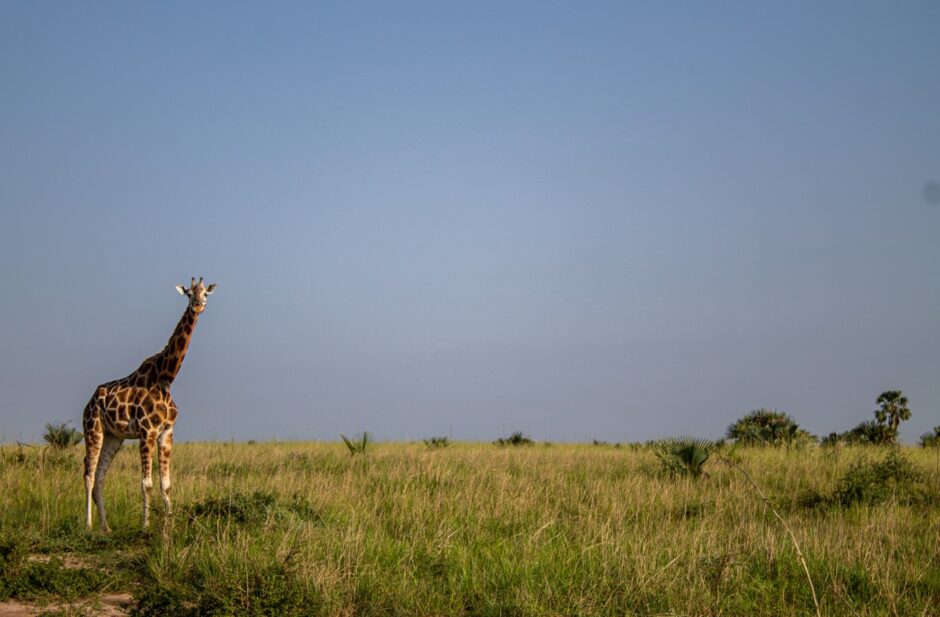Praise the Lord from the earth…
Beasts and all livestock,
creeping things and flying birds!
(Psalm 148:7–10)
THE GIRAFFE IS ONE OF THE iconic animals of the great African plains, roaming the open grasslands in small groups of about half a dozen, and using its extraordinarily long legs and neck to browse high up in the acacia trees.
Giraffes are the world’s tallest mammals: males can grow up to 5.5 metres in height, with a neck Iength of 1.8 metres. Giraffes are already 1.8 metres tall at birth; female giraffes give birth standing up, and the newborn calf drops head first to the ground from a height of around 1.8 metres, which causes it to take its first big breath. Newborns are up and walking around after about one hour.
Like the rest of its body the giraffe’s tongue is very long. It can measure over half a metre, and is blue-black to prevent sunburn. Its leathery surface enables it to avoid injury from the thorns of the acacia and other food plants. Giraffes eat most of the time, and, like cows, they regurgitate their food and chew it as cud. A giraffe eats hundreds of kilos of leaves each week and must travel many miles to find enough food.
The generic name, Giraffa camelopardalis, means ‘one who walks swiftly, a camel marked like a leopard’. Giraffes have humps on their backs like camels (although giraffes’ humps are smaller), and can go without drinking water for long periods, surviving on the moisture content of their diet of acacia leaves.
Circulation to Match
The giraffes’ stature means that they are generally immune to predators, and they can defend themselves by kicking with their long legs. Their height, however, can also be a disadvantage. The blood vessels in the lower legs are under great pressure because of the weight of fluid pressing down on them from above. In other animals such pressure would force the blood out through the capillary walls. Giraffes, however, have a very tight sheath of thick skin over their lower limbs, which is able to retain the extra pressure, in addition to which all the arteries and veins are routed unusually deep within the legs.
To drink at a water hole they must spread their legs and bend down in an apparently awkward position. This introduces one of the most remarkable features of the giraffe anatomy, the blood circulation system. To ensure that blood reaches the brain, up to 5.5 metres above the ground, the giraffe has a large heart which maintains a very high blood pressure, double that of the average large mammal. This means, however, that when the giraffe bends down to drink or to browse low-growing plants its brain would normally be subjected to such high pressure that haemorrhage and death should instantly follow. But this problem is averted by a unique system, the rete mirabile (or ‘marvellous net’), a collection of reinforced artery walls, special valves, a mass of spongy tissue below the brain and pressure-sensing signals, which together maintain an adequate blood flow to the brain at just the right pressure.
Another problem caused by the long neck is the large dead volume of air in the 3.5-metre long trachea. When the animal takes in a fresh breath, the oxygen-depleted previous breath cannot be totally expelled. Consequently there must be enough lung volume to make this “bad air” a small percentage of the total, and the giraffe’s lungs are indeed very large, about eight times the size of those of humans.
Divine Design or Evolution?
Naturally, the unique neck and leg length of the giraffe have fuelled great interest among evolutionists. They have interpreted these features as a classic result of natural selection: the giraffe must have acquired its height in order to feed on leaves beyond the reach of competing browsers such as antelope and gazelles.
But in fact this claim for evolution is based less on evidence than on armchair reasoning, and it turns out to be unsafe: for field research has shown that, although their height does confer an advantage when lower leaves have already been eaten, giraffes actually prefer certain types of leaves rather than those at particular heights. During the dry season, when competition is most intense, they generally feed on low shrubs and spend much of the time with their necks horizontal!
A more recent popular suggestion has been that sexual selection drove the development of the giraffe’s neck. Male giraffes compete for females by ‘necking’ and ‘head clubbing’ one another, those with the longest necks and heaviest heads tending to win. However, a study has shown that long necks are no more exaggerated in males than in females, and that the theory fails to meet a number of tests for this type of selection. The researchers conclude that there is still no consensus on the origin of the giraffe’s neck, and it still presents a major problem for Darwinists.
Biologists seek in vain for evolutionary explanations of these remarkable features: there is no known decisive selective advantage in the giraffe’s long neck, and natural selection would have had to alter the legs, tongue, muscles, lungs, heart and blood-flow system simultaneously in order to achieve success.
Remarkably, there is only one species of giraffe, with nine subspecies recognised by their different patterns of spots. There is no other species of animal sharing its unique features of length of legs and neck. Its nearest relative, the okapi, is a resident of the dense African forests, not the plains; it has a long tongue but normal leg and neck lengths. Everything about the giraffe points to a creature whose anatomy and features are unique and designed as a complete package.
The authors of one study, in dismissing sexual selection, concluded that “Better explanations for neck elongation must be sought elsewhere.”* That ‘elsewhere’ is in the Word of God, which assures us that ‘God made the beasts of the earth according to their kinds and the livestock according to their kinds, and everything that creeps on the ground according to its kind. And God saw that it was good’ (Genesis 1:25).
God made the beasts of the earth for His (and our) pleasure.
David Burges
from Wonders of Creation
reproduced by permission of The Christadelphian
* G Mitchell, S J Van Sittert, S D Skinner, Sexual selection is not the origin of long necks in giraffes: Journal of Zoology Volume 278 Issue 4 2009



